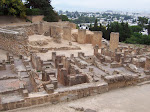Sorry for another long break in updates. Our final project involves a 25-40 pg. paper, and research for mine, on tourism in the Sahara, has been taking up most of my free time. Well, that and Stanley Cup playoffs (go Hawks and Pens!). Thank God for internet streams, not even Tunisia can keep me away from my hockey!
Regardless, here's another installment of my trip up to the northern part of the country. We left Bizerte the next morning and drove through the rural village of Sejnane, known for its beautiful pottery, handmade by the women in the village. We stopped for a demonstration, which was very interesting, to watch the women make perfectly symmetrical pieces without a pottery wheel or any modern equipment. The most fun part of the stop, though, was playing with the baby goats and the village kids. We spent more time than expected when a pick up game of soccer started up. The lazy cows chewing on grass in the fields made great impromptu goals. They were probably wondering why we kept kicking a ball in between their legs but they didn't seem to mind. The children were also eager to talk to us about the newborn goats, just days old. Did we have any goats, they asked? When we explained to them that no, we had no goats, they suddenly understood why we were fawning over theirs.
No pictures from Sejnane, unfortunately. My camera was still broken. I'll try to see if anyone else in my group has some.
None of us were very excited about leaving the kids or the baby goats behind, but we eventually had to leave and get back on the road to Tabarka. Tabarka is a very neat coastal village with rock formations called "the needles". It is also home to a large Genoese castle occupying an island that was once popular with pirates. We went up to the castle to try to get inside but the caretaker was out for the evening. Tabarka is also known for its coral reefs, some of the best in the Mediterranean, and for the wild boar, a specialty dish made for tourists, as Muslims don't eat it. The hotel we stayed at prepared wild boar for us that night. It's delicious.
The pirate stories from Tabarka are exciting, just like the ones from Djerba. I've come to the conclusion that Tunisia is just full of swashbuckling pirate adventures. In 1541, the Turkish corsair, Barbarossa, surrendered the island to Charles V of Spain in return for the release of his friend, Dragut, who was being held in a Christian prison. The next year, Charles sold the island and the fishing rights to a Genoese family called Lomellini who built the castle and helped fill the town with twelve hundred inhabitants. The family stayed there, despite Turkish control of the mainland, for 2 centuries.
Here are some photos of Tabarka: the needles, the castle, crashing waves and the port.
























